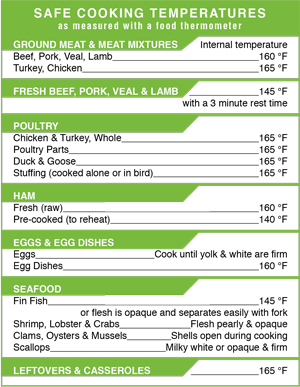How Not To Kill Your Family And Friends With Your Weekend Cookout
There’s a reason people in the food service industry are trained and tested on safe kitchen practices. Food safety is no joke, and the risk of dangerous foodborne bacteria is very real. And when we bring food out of kitchens and into the great outdoors, where temperatures aren’t regulated, it becomes even more serious.
Dining outdoors is great in the warmer months, but it also means that our food can get warmer than is safe. If improperly stored, or cross-contamination happens, the growth of foodborne bacteria multiplies.
Let’s all stay safe this summer. Here are a list of things outlined by the FDA to keep in mind before you start planning your next outdoor meal ― and make sure that you don’t make your friends and family sick.

1. Keep cold foods cold. Pack a cooler with ice or ice packs to ensure cold food will be stored below 40 degrees. And consider packing drinks in a separate cooler to keep the opening of the cold food cooler to a minimum. Also, keep this cooler out of direct sunlight as much as possible.
2. Keep hot foods hot. Hot food should be kept at a temperature of 140 degrees Fahrenheit or above. You can use a thermos or insulated container. Or, if you’ve just grilled food, keep it hot until ready to serve by moving it to the side of the grill rack away from the heat. Do not partially cook food unless you can finish cooking it right away ― for example. if you’re taking it from the stove to a grill outside.
3. Be wary of the “Danger Zone.” For food, the danger zone is any temperature above 40 degrees F (for cold foods) and under 140 degrees F (for hot foods). If foods are kept in the danger zone temperatures for over two hours, they should be tossed. If the outdoor temperature is above 90 degrees, foods should be tossed just after an hour.
4. Don’t cross-contaminate. You might not even realize you’re doing it, but it’s one of the surest ways to make people sick. Don’t reuse a plate or utensil that may have been in contact with raw meat, poultry or seafood. This is very important to remember when serving cooked food from a grill, but also something to keep in mind when packing a cooler. Keep raw meat, poultry and seafood securely wrapped to make sure no raw juices get in contact with the other contents of your cooler.
5. Use a thermometer. Bring a meat thermometer and use it. The cooking temperatures you’re looking for are outlined in the chart below. And, consider using an appliance thermometer for your cold cooler too ― just to make sure it’s chilling below 40 degrees.

6. Wash your hands. Just do it, even if you don’t have access to running water. You can use a jug of water and soap ― or even a moist towelette in a pinch. Just keep your hands clean.
Follow all those rules, and you can dine al fresco without a care in the world.
Related...
15 Things You Should Be Grilling (That You Probably Aren't)
50 Grilling Recipes That'll Cover All Of Your Summertime Needs
The Steak Cuts You Should (And Shouldn't) Be Grilling
The Burger Recipes That'll Switch Things Up This Summer
The Scientific Reason Grilled Steak Is So Delicious
Also on HuffPost
Love HuffPost? Become a founding member of HuffPost Plus today.
This article originally appeared on HuffPost.

